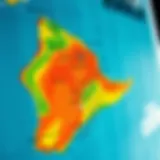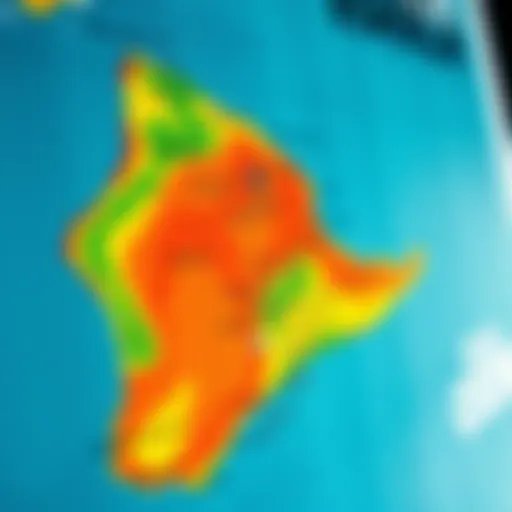Understanding Wind Direction for Kiteboarding Success
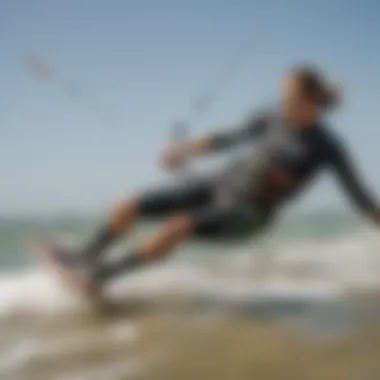

Intro
Kiteboarding is not just a sport; it's a delicate dance with the wind. The direction and strength of the wind can shape the entire experience for kiteboarders, whether they are riding on calm lakes or over exhilarating ocean swells. It’s crucial to grasp how current wind directions affect both performance and safety. Knowing how to interpret wind patterns can make all the difference in choosing the right spot for kiteboarding and ensuring a thrilling yet safe adventure.
In this article, we'll dig into the importance of wind directions for kiteboarders. We will break down the various tools available for reading wind data and examine how local geography plays a significant role in wind behavior. This comprehensive guide aims to cater to both novice and seasoned riders, giving insights you might not find in standard textbooks or beginner guides. Let's get right into it.
Importance of Wind Direction in Kiteboarding
Wind direction is the unsung hero in the world of kiteboarding. It drives not just the thrill of the ride but also has a direct link to safety and performance. Understanding how wind behaves can amplify your kiteboarding experience or lead to a misadventure—there's no two ways about it.
Impact on Performance and Safety
The wind isn’t just an abstract concept for kiteboarders; it is the lifeblood of the sport. A kite surfers' speed, agility, and maneuverability depend heavily on the wind direction. When the wind is blowing properly—meaning that it’s consistently hitting you from the right angle—you can ride smoothly and take full advantage of the kite's lift. Feeling the power transfer through your sails is nothing short of exhilarating.
On the flip side, when the wind doesn't cooperate, the consequences can be serious. A sudden gust or an unexpected shift in direction can throw a kiteboarder off balance, leading to falls that are more than just a bruised ego. By paying attention to the wind, kiteboarders can anticipate the ride and adjust their actions accordingly. It's about reading the signs nature gives you.
From a safety standpoint, understanding wind direction helps kiteboarders choose spots that are windward or leeward relative to their launch site. Choosing to launch your kite in windward direction shields you from unpredictable gusts. Similarly, being aware that you’re heading leeward can help you gauge when to call it quits if the wind shifts too much or starts to become hazardous.
In short, knowing where the wind is coming from and where it's going not only enhances performance but also plays a critical role in safety. It allows kiteboarders to adapt their techniques based on the wind’s tendencies, enhancing both the skill and enjoyment of the sport.
Understanding Wind Windward and Leeward
The concepts of windward and leeward are fundamental in kiteboarding, yet many new kiteboarders may not fully grasp their significance—yet this understanding significantly impacts your experience on the water.
Windward refers to the direction from which the wind is coming. Think of it as standing with your face to the breeze. Launching your kite here means you're working with the wind to help you lift off effectively. Most seasoned kiteboarders will choose a windward launch because it maximizes control and minimizes risk.
On the contrary, the leeward side is where the wind is heading. It’s like being on the downwind side of a hill—you're out of the main wind flow. Launching here can be trickier; if the wind suddenly shifts or dies down, you might find yourself in a tight spot, drifting farther away from safety.
Here’s a helpful breakdown:
- Windward: Favorable for launching, easy to control your kite.
- Leeward: Riskier; potential for unpredictable conditions.
To ensure a safe and thrilling experience, knowing which way the wind blows and how it behaves in your location is paramount. Pay close attention to local weather forecasts and wind patterns before heading out. It's all part of becoming a savvy kiteboarder, and it opens up new pathways for exploration on the water, whether you’re a weekend warrior or a hardcore adventurer.
Key Wind Terminology
Understanding wind terminology is crucial for kiteboarders. It establishes a foundational knowledge that can enhance both safety and performance on the water. By grasping the different aspects of wind direction and speed, enthusiasts can better interpret conditions that are favorable for kiteboarding. For example, comprehension of terms like "updrafts" or "Beaufort Scale" can not only dictate the choice of location but can also help in making informed decisions before launching.
Definitions of Wind Directions
Northeast, Southeast, Southwest, Northwest
Wind directions, denoted by compass points, play a significant role for kiteboarders. Each direction brings its own characteristics that can either aid or hinder a session on the water.
- Northeast winds are often cool and steady, providing ideal conditions for beginners. The key characteristic of this wind is its consistency, which can lead to reliable riding conditions.
- Southeast winds, on the other hand, can shift unexpectedly. While they may be strong, they often throw a curveball by carrying gusts. This may make them a choice to approach with caution, especially for novices.
- Southwest winds typically occur in warmer regions and can lead to enjoyable kiteboarding experiences. The warm air can boost performance due to its buoyancy, allowing for exciting aerial maneuvers.
- Northwest winds can be unpredictable, especially due to topographical influences. They often come with fluctuations that require experienced riders to adapt quickly.
By examining these winds, one can discern the appropriate times to head out. While it's possible to have fun in varying conditions, understanding the advantages and disadvantages of each wind direction is vital.
Updrafts and Downdrafts
Updrafts and downdrafts are key elements related to kiteboarding safety and performance.
- Updrafts, which occur when warm air rises, can provide lift to kiteboarders. These surges of wind can enhance a rider's ability to stay airborne and perform tricks. However, they can be unpredictable and sometimes erratic, necessitating a careful understanding of local conditions as kiteboarders seek out thermal lifts to push their limits.
- Downdrafts, in contrast, can be dangerous, indicating a change in pressure that pulls air downward. Riding in an area affected by downdrafts can lead to sudden crashes or loss of control. It's critical to discern when these winds are present and how to navigate them effectively.
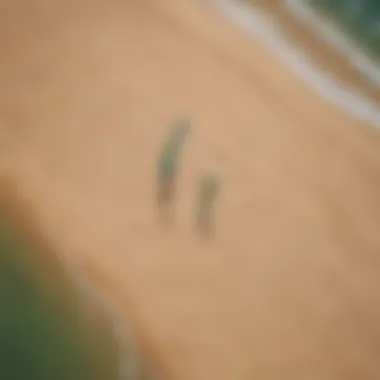

Understanding Wind Speed and Its Measurement
Wind speed is another vital component in kiteboarding, as it dictates what kind of equipment to use and the overall feasibility of a session. An accurate gauge of wind speed helps prevent mishaps.
Beaufort Scale
The Beaufort Scale is an integral tool for kiteboarders. This scale simplifies the measurement of wind speeds, categorizing them from calm to hurricane-force winds.
- Key characteristic of the Beaufort Scale is its straightforward nature, allowing anyone to gauge conditions without special instruments. A wind speed of about 12 to 18 knots, categorized as a Force 4 on the scale, can be deemed breezy and highly enjoyable for intermediate riders.
It can significantly help in equipping oneself. Understanding what each force implies can save a lot of trouble on the water.
Anemometers
Anemometers are specialized devices that measure wind speed. This sophisticated tool is beneficial for kiteboarders aiming to achieve optimal riding conditions.
- Key characteristic of anemometers is their precision. Unlike the Beaufort Scale, which is more subjective, an anemometer gives numerical values that inform immediate decision-making.
Using an anemometer will ensure proper kite selection based on wind conditions. This helps in maximizing enjoyment while mitigating the risks associated with an ill-advised launch.
Tools for Tracking Wind Direction
In kiteboarding, understanding wind direction is crucial for both safety and performance. Hence, utilizing proper tools to track wind patterns becomes paramount. These tools help kiteboarders make informed decisions about when and where to ride, ensuring they maximize their experience without compromising their safety. With the advancements in technology and the expanding kiteboarding community, many resources are now accessible, catering to a range of preferences and skill levels.
Online Wind Maps
Web-based resources
Web-based resources stand out for their real-time data and accessibility. Kiteboarders can easily check wind conditions from the comfort of their homes, allowing them to plan ahead. A key characteristic of these resources is their ability to present complex weather data in a user-friendly manner. For instance, sites like Windy and Windfinder often provide visuals that depict wind speed and direction visually, making it easy for anyone to interpret quickly.
However, it’s worth noting that sometimes these maps can be misleading. Local variations in wind can occur that aren’t reflected in the online data. Still, for the most part, they serve as an excellent first step in gauging conditions before heading out.
Mobile applications
Mobile applications add another layer of convenience for kiteboarders on the go. These apps provide real-time updates and alerts, which is invaluable when conditions can change rapidly. The primary allure of many kiteboarding apps, such as Kitesurfing Weather and iKitesurf, is their push notifications feature, alerting users of wind changes as they happen.
Moreover, these applications often integrate local community reports, giving users a more complete picture of the conditions. Still, the downside may be that not all apps offer the same level of accuracy. User-generated data can sometimes be hit or miss, but many enthusiasts find this communal aspect of kiteboarding appealing and useful.
Local Weather Stations
Local weather stations play a vital role in providing context-specific wind data. Their stations are strategically located, monitoring weather conditions more accurately than broad-scale models. Often run by meteorological organizations or universities, these stations can give real-time wind reports that include not just direction but also gusty conditions.
It’s critical for kiteboarders to familiarize themselves with their local weather stations, as they can be the difference between a good session and one that’s fraught with unpredictability.
Kiteboarding Community Resources
User-generated wind reports
User-generated wind reports have emerged as a valuable tool for kiteboarders in understanding current conditions. These reports, shared by fellow kiteboarders, provide firsthand accounts of wind behavior at specific spots. A key characteristic of these reports is their immediacy and local knowledge. Kiteboarders on sites like Reddit or Facebook can communicate real-time updates that are often more localized than formal forecasts, making these resources quite popular.
Still, it’s essential to approach these reports with a critical mind. The variability in personal experience can introduce bias, as one person’s ideal conditions might be undesirable for another. Nonetheless, many riders find the community aspect enriching and, in many ways, indispensable.
Social media insights


Social media insights represent another innovative channel for kiteboarders to gather information. Platforms like Instagram and Facebook are teeming with kiteboarding communities sharing their experiences and photos, showcasing where the wind is blowing. These real-time updates often come with visual proof, which can be very convincing.
However, while social media is a good source of buzz about wind conditions, it can also be a mixed bag of information quality. The immediacy of posts means that not all are accurate or useful. It’s always wise to cross-reference with more established resources before heading out.
As kiteboarding continues to grow, the array of tools available to track wind direction reflects this. Each option, whether online maps, apps, or community shares, offers unique advantages, making wind direction tracking a critical topic in this exhilarating sport.
Local Geography and Wind Behavior
Understanding how local geography influences wind behavior is paramount for kiteboarders. This connection helps riders select ideal locations and make informed decisions about safety and performance. Each region brings its unique characteristics, which can significantly impact wind patterns. Knowing how these geographical nuances affect wind behavior can lead to more rewarding sessions on the water.
Effects of Topography
Wind Shadow Regions
Wind shadow regions are areas where the wind's natural flow is obstructed by geographical features, such as hills or buildings. This obstruction can create a significant difference in wind conditions, leading to
calm spots where the wind is notably lighter. One notable characteristic of these regions is that they often create turbulence as wind flows around obstacles. This can pose challenges for kiteboarders who might not expect sudden changes in wind conditions.
For example, kiteboarders who launch near tall cliffs may experience powerful gusts in the open area but step into a lighter breeze upon entering a sheltered spot just behind the cliff. This inconsistency necessitates a cautious approach when selecting launch and landing points, especially for less experienced riders.
While wind shadow regions can offer some ideal spots for those practicing low-wind techniques, they may also prove tricky for those wanting consistent wind. Understanding these areas makes kiteboarding in a specific local topography less of a gamble.
Ocean Currents and Wind Patterns
Ocean currents have a profound influence on wind patterns through their interaction with coastal geography. The temperature difference between land and water creates varied pressure zones, inducing wind currents that kiteboarders need to monitor. A key characteristic of ocean currents is that they can alter wind strength and direction, shaping the overall wind profile in a given area.
In places like Maui, Hawaii, the consistent tradewinds combined with ocean currents create some of the best kiteboarding conditions found anywhere. The water current can push the wind upward, enhancing its velocity and making for thrilling rides. But this can also lead to challenges if riders are unprepared for sudden increases in wind speed.
This dual nature of ocean currents means that understanding their strengths and seasonal behaviors is beneficial. Kiteboarders can plan their outings around optimal conditions, taking advantage of not just the winds but also the ocean's flow for a more enjoyable experience. However, every potential benefit pairs with a possible drawback; erratic shifts can cause challenging situations, highlighting the essence of preparation and awareness in these locales.
Common Kiteboarding Locations and Their Wind Profiles
Different kiteboarding locations have unique wind profiles that are shaped by local geography. Here are some notable examples:
- Cabo Verde: Renowned for cross-shore winds, enhancing performance during most kiteboarding seasons.
- Maui, Hawaii: Consistent tradewinds coupled with ocean currents provide exceptional levels of activity.
- Tarifa, Spain: Its strategic positioning results in strong winds, ideal for various skill levels.
In each locality, kiteboarders need to carry out detailed assessments of the wind profiles to ensure safe and enjoyable sessions, recognizing how local topography and oceanic features play into their experience.
Interpreting Wind Forecasts
Understanding how to interpret wind forecasts is crucial for kiteboarders aiming to make the most of their time on the water. Not only does this knowledge enhance performance, but it also plays a key role in safety. The wind can change in the blink of an eye, and being able to read these shifts can prevent potentially dangerous situations as well as maximize the enjoyment of the sport.
Reading Weather Models
When it comes to reading weather models, kiteboarders should get familiar with several types of forecasts. These models utilize data from various sources to predict wind conditions, helping riders to make informed decisions. Key points to consider while interpreting these models include:
- Global and Regional Models: Global models give a broad overview, while regional models dive deeper into local conditions. A global model might tell you generally what to expect for the day, but regional models can provide specifics you can trust for that particular kiteboarding spot.
- Time Frames: Forecasts can range from short-term (hourly) to long-term (days in advance). For immediate decisions, short-term forecasts can be more reliable. That said, keeping an eye on longer trends can also be beneficial.
- Model Accuracy: Not all weather models are created equal. Some are more precise than others, and knowing which ones to trust can save you from unexpected surprises out there on the waves.
A promising approach is to check multiple sources and see where they agree and disagree. By gathering insights from various platforms, you can form a more comprehensive picture of what to expect when hitting the water.
Understanding Wind Predictions
Wind predictions can be a mixed bag. The accuracy of these predictions hinges on several factors, including the technology in use and the area’s unique weather behaviors. To get the most out of wind predictions while planning your kiteboarding adventures, keep the following points in mind:
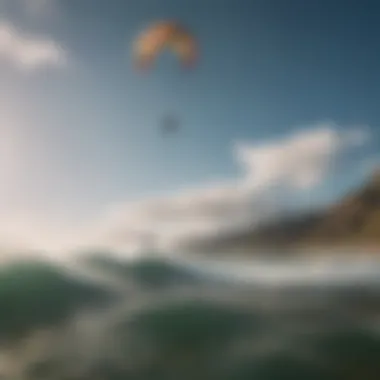

- Local Knowledge: Understanding your local environment is key. For instance, the wind might behave differently at a lake than it does at an ocean beach because of geographical factors like land formations. Local kiteboarding clubs or experienced riders might have a wealth of knowledge worth tapping into.
- Windsurfing and Kiteboarding Apps: Many kiteboarders rely on specific apps that provide real-time data about wind conditions. These apps usually include user-generated content, adding a layer of community intelligence that can be beneficial. Out there, sharing what you see can sharpen everyone’s experience.
- Pay Attention to Trends: Wind patterns can reveal habitual tendencies over time. If you know that the wind often shifts during certain times of the day or with specific weather conditions, you can plan your outings accordingly.
The ability to accurately interpret wind forecasts is a significant skill that differentiates an experienced kiteboarder from a novice. Keeping an eye on shifting conditions not only enhances fun but can also ensure safety on the water.
By equipping yourself with the know-how to interpret wind forecasts and being adept at reading the wind, you can drastically elevate your kiteboarding game. This skill not only leads to better performance but also aids in navigating hazards, reinforcing the essence of kiteboarding as a thrilling yet responsible adventure.
Safety Precautions Related to Wind Conditions
Wind conditions can make or break a kiteboarding session. Before even thinking about launching, kiteboarders must assess the wind readings accurately. This will not only enhance performance but is paramount for safety. Strong winds can pose severe hazards, and being aware of one’s surroundings, as well as local forecasts, can mean the difference between a fun day on the water and an emergency situation.
To ensure a safer kiteboarding experience, knowing how to interpret wind direction and speed is essential. An informed kiteboarder can anticipate changes and react accordingly. This awareness leads to not only a more enjoyable ride but also minimizes the risk of accidents.
Assessing Wind Readings Before Launching
Before hitting the water, correctly assessing wind readings is vital. This involves checking both the speed and direction of the wind. It’s recommended to use tools like anemometers, which provide accurate measurements. Many kiteboarders also rely on their instincts; just standing on the shore for a moment can offer a lot of insights. If the flags are whipping wildly or there’s a discernible roar in the air, it might be a clue that conditions are harsher than they seem.
Moreover, evaluating the kitesurfing environment is important as natural elements like buildings and trees affect wind flow. The wind might be calmer off shore than it appears on land due to obstructions or wind shadows. These very small local changes can cause significant differences in the overall wind conditions. So, take a moment to watch the water, the waves, and fellow riders before launching.
Recognizing Hazardous Wind Conditions
As someone who spends time on the water, understanding when wind conditions turn hazardous is critical. Below are two notable conditions to be cautious of:
Strong Gusts
Strong gusts are sudden increases in wind speed that can catch even the most seasoned kiteboarders off guard. They can change the dynamics of riding dramatically. One moment everything feels manageable, and the next, a gust hits, throwing off balance and control. The characteristic of strong gusts is their unpredictable nature, making them a significant reason for accidents.
Gusts can lead to excessive power in the kite, which creates a challenge in controlling it properly. As such, kiteboarders must be alert and prepared to steer their kite safely when they sense a gust coming. When riding in rough conditions, it’s important to find a safe zone away from potentially dangerous areas like rocky shores or other riders, to minimize risks.
Storm Fronts
Storm fronts are another dangerous wind condition to be aware of while kiteboarding. Typically, they come with a dramatic shift in weather patterns and can result in turbulent and unstable winds. The primary characteristic of storm fronts is their unpredictability. Often, they bring with them dark skies and dropping temperatures, and it’s a sure sign to head back to shore.
The unique feature of storm fronts isn’t just the change in winds but also the potential for severe weather, including lightning, that can make kiteboarding very dangerous. Kiteboarders should stay informed and heed warnings about weather changes. Relying on local weather apps or online resources can be valuable when considering whether to venture out.
"When in doubt, err on the side of caution. The water will still be there tomorrow, but safety is a one-time deal."
In summary, assessing wind conditions and recognizing hazardous situations are essential for kiteboarding. Whether it’s strong gusts or storm fronts, understanding these aspects ensures kiteboarders can enjoy their sport to the fullest, without putting themselves or others at risk.
The Future of Wind Direction Tools
The ever-evolving landscape of kiteboarding necessitates an equally dynamic approach to understanding wind direction. As kiteboarders increasingly seek out reliable information, the future of wind direction tools stands as a crucial aspect in enhancing their experience on the water. The intersection of technology and community engagement will play a pivotal role in how kiteboarders interpret wind data, make informed decisions, and ultimately enjoy their sessions safely.
Emerging Technologies for Wind Tracking
The digital age is ushering in a slew of emerging technologies that promise to refine how we track wind conditions. For instance, drone technology is carving out a niche in this arena by providing real-time aerial assessments of wind direction and speed. These high-flying gadgets can offer a bird's-eye view of conditions at various altitudes, revealing patterns that ground-level tools might miss.
Additionally, advancements in sensor technology are becoming more commonplace, giving kiteboarders access to more precise data. Smart sensors mounted on kites or offshore buoys can send back data directly to a user’s smartphone, offering immediate insights into changing conditions. This instantaneous feedback not only aids in decision-making but also aligns with the fast-paced nature of the sport.
Moreover, the development of augmented reality (AR) applications is also making waves. Imagine wearing AR glasses that superimpose wind direction and speed information right into your field of vision while you’re on the water. This could drastically reduce the downtime between sessions and improve both performance and safety.
The Role of Community in Enhancing Reporting
Kiteboarding is far more than just a sport; it's a community, and this communal aspect extends to how wind data is reported and shared. Platforms like Reddit and Facebook have become invaluable for kiteboarders, allowing them to share real-time updates on wind conditions and experiences at specific locations. Such communal sharing can paint a more accurate picture of local conditions than any single weather app.
Understanding that personal accounts can sometimes offer insight that raw data can't, many kiteboarders are turning to these social media platforms to fine-tune their knowledge of local spots. Regular updates from fellow riders help newcomers be aware of new obstacles, sudden changes in wind patterns, and even the best times to hit the water.
Furthermore, organizing community-based reporting initiatives can harness collective knowledge. This could lead to the establishment of localized wind observation networks, where experienced riders contribute to reports that help novices pick up valuable tips and tricks. Engaging with community resources enriches the collective understanding of conditions while ensuring that safety concerns are promptly highlighted.
The community not only enhances reporting but also fosters relationships that can lead to safer and more enjoyable kiteboarding experiences.
In sum, the future of wind direction tools in kiteboarding is bright, with technological advancements working synergistically with community insights. As kiteboarders harness these resources, they will undoubtedly be better equipped to navigate the challenges of wind conditions, leading to more exhilarating sessions on the water.










